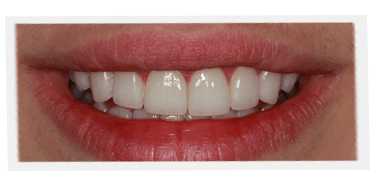
People often dislike certain aspects of their smile. It’s too big. It’s too small. It’s too something. The dentist, though, needs to be able to analyze and quantify what’s behind these reactions. Using the classifications and principles we’ve seen in previous articles, dentists today should be able to look at smiles that are not pleasing and figure out aesthetically, mathematically, and scientifically what is wrong with them – and say to their patients, “Now this is what would work.” Let’s look at some of the tools that can be used to fix smiles. After that, we’ll examine specific smile problems and their solutions. (Excerpt from my book, A Guide to the Perfect Smile.)
The Cosmetic Dentistry Toolbox
Following is quick survey of some of the products, services, and procedures currently available to dentists.
Veneers and Crowns
Veneers are commonly used to correct aesthetic dental problems such as defects, problems with shape, crookedness, and gaps. An advantage of applying veneers, compared with applying crowns, is that the tooth does not usually need to be ground down much to create room for the veneers. By keeping as much of the tooth structure as possible, the veneer can be quite thin over the intact, good part of the tooth, and then be thicker where the correction is needed.
Veneers are not cemented but are permanently bonded to the remaining tooth structure. As, such, the refractive light properties of a veneer are similar to those of the natural tooth, creating a highly natural result. Veneers can be painted and stained to match the natural teeth, but layering is still preferred. (More on layering, later.)
Because veneers are highly transparent and bond seamlessly to the tooth, the edges of the veneers do not have to be placed underneath the gum line, which enables the health of the gum line and the natural tooth to be kept intact. This is a large advantage over crowns, which generally do go below the gum line. Crowns are inherently reflective, in order not to show the metal underneath. They are therefore extra difficult to match up properly against natural teeth. As well, should the gum line recede over time, the margin of a crown may become exposed and look unsightly.
Crowns are the treatment of choice, however, when the entire surface of the tooth is a problem but the root system is intact. Traditionally, when they were first introduced, crowns were cast and made from solid yellow gold. Today, even though they are not considered aesthetic, gold crowns continue to be the longest-term, most predictable solutions.
To meet aesthetic needs, most crowns are now made from gold that is covered with tooth-colored porcelain. These porcelain-fused-to-metal crowns are the standard in most practices. However, their degree of aesthetic naturalness and beauty is highly dependent on the artistic skill of the ceramist. But there is a possibility of porcelain chipping with this type of crown, exposing the unsightly metal.
Most recently, to address the need for higher aesthetics, zirconia – which is a good replacement for metal and yet is tooth colored – has been used to eliminate the metal under the crowns and the black line or hue often seen around the edges of porcelain-fused-to-metal crowns.
Bridges
Bridges are single or multiple false teeth that are fused between two crowns on the two adjacent teeth in order to replace missing teeth. These crowns are bonded or cemented to the teeth on either side of the space.
Although bridges, to appear natural, are traditionally coated in tooth-colored porcelain on the outside, a metal underlying support is usually employed to provide strength for the bridge. Currently, zirconia is used to replace the metal for strength, thus providing an all-tooth-colored structure.



